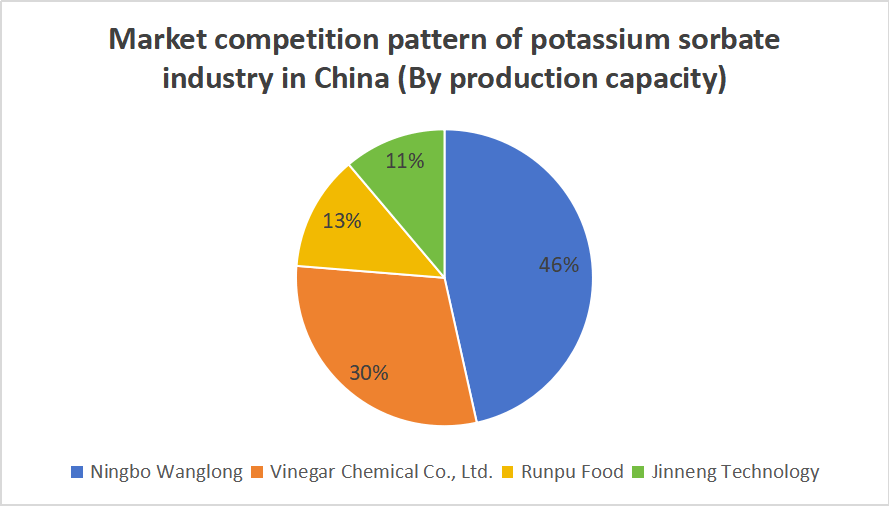Global potassium sorbate production capacity distribution
From the perspective of the market structure of potassium sorbate, the global potassium sorbate production capacity is mainly distributed in China, and the industry concentration is relatively high. The main production enterprises include Runpu Food (13,500 tons), Ningbo Wanglong (50,000 tons), Vinegar Chemical Co., Ltd. (30,000 tons), Jinneng Technology (15,000 tons), Guangxi Jinyuan (20,000 tons), Kunda Biological (15,000 tons), Rugao Jiangbei and Changjiang, etc., totaling about 130,000-140,000 tons (Jinneng’s new expansion of 50,000 tons in June is not counted). In foreign countries, the main production enterprises are Japan Daicel and Germany Nutrinova, etc., with a scale of several thousand tons, and the products are mainly supplied to their respective domestic markets.

Potassium sorbate characteristics and application
Characteristics
Sorbic acid has the same antiseptic properties as potassium sorbate, but the structure of sorbic acid is similar to fatty acids, and its solubility in water is average. After further processing into potassium sorbate, potassium sorbate can be well dissolved in water.
Application
Potassium sorbate is a widely used food preservative, and its main applications include:
Alcohol and beverages:
Potassium sorbate is often added to beverages such as wine, soda drinks, fresh orange juice, hawthorn juice, etc. to extend the shelf life and prevent mold.
Soy sauce and sauce products:
Adding appropriate concentrations of potassium sorbate to soy sauce, sauce products, and pickled products can prevent mold and deterioration.
Aquatic products:
Adding potassium sorbate to aquatic products such as fish cakes, fish sausages, and smoked fish products can effectively prevent mold problems in the products and extend the storage time.
Meat products:
Adding potassium sorbate to meat products such as dried meat, dried sausages, beef sausages, and pork sausages can significantly extend the shelf life, which is usually twice that of unused ones.
Preservation of vegetables and fruits:
Adding potassium sorbate preservatives to vegetables and fruits can keep them for more than one month at 30°C and keep the greenness unchanged.
Pastry preservation: Potassium sorbate is added to the flour raw materials, water or milk used to make pastries, and is used to preserve pastries.
Annual per capita potassium sorbate consumption in China and the United States
According to the prospectus of Runpu Food, the per capita potassium sorbate consumption in the United States is about 60g/year, while the per capita potassium sorbate consumption in China is about 10g/year. The domestic potassium sorbate market in China has good development potential.
Supply and demand analysis of potassium sorbate
From the perspective of the potassium sorbate industry chain, the main raw materials of potassium sorbate are acetic acid, potassium hydroxide, and crotonaldehyde, and their prices fluctuate greatly. However, due to market reasons, the demand is not good, and the factory product prices have been falling. In addition, the impact of Jinneng’s 50,000 tons of new products on the market is expected to decline or maintain product prices in the future.
Future prospects of potassium sorbate
Sorbic acid and potassium sorbate have better preservative effects and food safety than others, and the market size has grown rapidly in recent years. According to P&S Intelligence statistics, the global potassium sorbate market is expected to grow from US$360 million in 2020 to US$580 million in 2030, with a compound annual growth rate of 4.7%.
